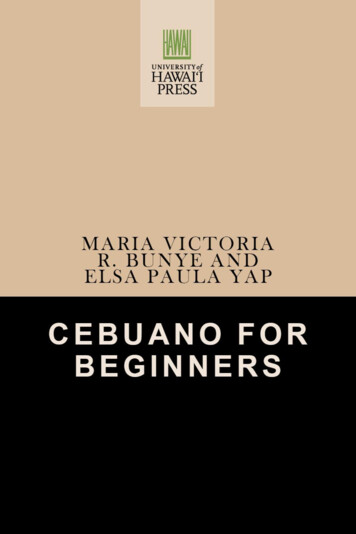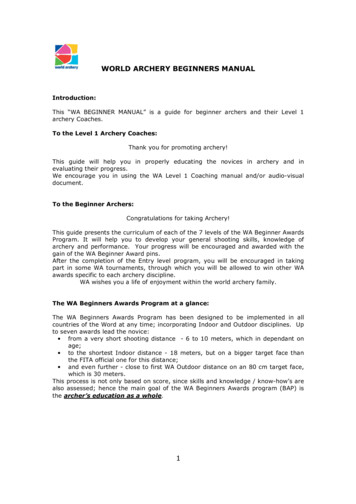
Transcription
CEBUANO FOR BEGINNERS
PALI Language Texts: Philippines(Pacific and Asian Linguistics Institute)Howard P. McKaughanEditor
CEBUANO FORBEGINNERSbyMaria Victoria R. BunyeandElsa Paula YapUniversity of Hawaii PressHonolulu 1971
Open Access edition funded by the NationalEndowment for the Humanities / Andrew W.Mellon Foundation Humanities Open BookProgram.Licensed under the terms of Creative CommonsAttribution-NonCommercial-ShareAlike 4.0 International (CC BY-NC-SA 4.0), which permits readers to freelydownload and share the work in print or electronic format fornon-commercial purposes, so long as credit is given to theauthor. The license also permits readers to create and share derivatives of the work, so long as such derivatives are sharedunder the same terms of this license. Commercial uses tps://creativecommons.org/licenses/by-nc-sa/4.0/. The Creative Commons license described above does not apply to anymaterial that is separately copyrighted.Open Access ISBNs:9780824879778 (PDF)9780824879761 (EPUB)This version created: 30 May, 2019Please visit www.hawaiiopen.org for more Open Access worksfrom University of Hawai‘i Press.The work reported herein was performed pursuant to a contractwith the Peace Corps, Washington, D.C. 20525. The opinions expressed herein are those of the authors and should not be construed as representing the opinions or policy of any agency ofthe United States Government.
Copyright 1971 by University of Hawaii PressAll rights reserved
PREFACEThe lessons herein were developed under a contract withthe Peace Corps (PC 25–1507) at the University of Hawaii underthe auspices of the Pacific and Asian Linguistics Institute.Earlier drafts of the lessons were tested in Peace Corps trainingsessions at Hilo, Hawaii.Many have contributed to their development. The authorsare indebted to trainees, instructors, coordinators and administrators of the Peace Corps for their suggestions and help.This text is one of a series. Others include a vocabulary andgrammatical notes for Cebuano and similar materials for otherPhilippine languages.Howard P. McKaughanEditorvii
CONTENTSPrefaceviiPart I: Introduction1Part II: The Language Textbook7Part III: Types of Pattern Drills9Part IV: Notes to the TeacherLESSON 1GreetingsParticles: [sab], [man], [pod]LESSON 2Greetings: variationParticle: [lang]LESSON 3Greetings: variationParticles: [man], [diay]LESSON 4Demonstrative Pronouns: kini-classQuestion Words: unsa, kinsaTopic Case Markers: [si], [ang]LESSON 5Personal Pronouns: 1st set, singular, akó-classInterrogative StatementsSupplementary Materials: Lessons 1–5LESSON 6Non-Verbal Affix: (taga-)Place Marker: [sa]LESSON 7Personal Pronouns: 1st set, plural, akó-classParticles: [na], [ra], [gyud]Verb: (mu-) classFocus: ActorMood: Factual and Non-FactualAspect: NeutralLESSON 3952
CONTENTSPersonal Pronouns: 2nd set, preposed possessive,áko-classAgentive Case Markers: [ni], [sa]Demonstrative Pronouns: nia-classTag Question: dili ba?Supplementary Materials: Lessons 6–8LESSON 9Adjectives: Simplex FormNon-verbal Affix: (-a/-ha)LESSON 10Adjectives: Simplex FormOblique Case Marker: [ug]Ligature: [nga]Supplementary Materials: Lessons 8-10LESSON 11Existential Form: adunaNegation: walaPersonal Pronouns: 3rd set, nako-classNoun Marker: (-y)LESSON 12Personal Pronouns: 3rd set, nako-class in IndirectDiscourseQuestion Words: asa, ngano, pilaParticles: [kay], [aron], [uban]Supplementary Materials: Lessons 11–12LESSON 13Question Word: hainDemonstrative Pronouns: nia-classSa-phrase indicating LocationVerb: (mag-) classFocus: ActorMood: Factual and Non-FactualAspect: ProgressiveSupplementary Materials: Lessons 11–13LESSON 14Question Words: pila, anus-aNon-Verbal Affix: (ika-)Particle: [ka]Months, Seasons, YearsNumeralsLESSON 15Question Word: tagpilaNon-Verbal Affix: (tag-)LESSON 132132132139
CONTENTSQuestion Words: pila, unsa139Days of the Week139Supplementary Materials: Lessons 14–16147LESSON 17149Hour Marker: [ala]/[alas]149Marker: [sa]149LESSON 17A155A Question Word: pila155Weights and Measures155LESSON 18162Pseudo-Verb: Gusto Non-Factual Mood of the verb 162Afactual Mood (Imperative) (pag-) V base162Negation: Ayaw V base162Supplementary Materials: Lessons 17–18173LESSON 19175Pseudo-Verb: kinahanglan Non-Factual Mood of theverb175Adverbial construction: [ug] adverb175LESSON 20186Verb: (mag-) classFocus: ActorMood: Factual and Non-FactualAspect: Progressive186Hortatory Expression: (mag-) class V kita186Supplementary Materials: Lessons 19–20196LESSON 21198Adjectives: Simplex Form198Non-Verbal Affixes: (ka-) (gi--on)198LESSON 22211Preposed Possessive Pronouns: 2nd set, áko-class211Non-Verbal Affix: (-a/-ha)211Adjectives:Pluralization: Non-Verbal Affix (-g-)Comparative Form: [mas] Adj baseSuperlative Form: [labing] Adj base211Personal Pronouns: 4th set, kanako-class211Supplementary Materials: Lessons 21–22225LESSON 23228Adjectives: Full Reduplication [pa]228Contrast between the particles [pa] and [na]228LESSON 24237Adjectives: Non-Verbal Affix (pala-)237x
CONTENTSVerb: (-on) classFocus: GoalMood: Factual and Non-FactualAspect: Neutral237Demonstrative Pronouns: niini-class237LESSON 25248Demonstrative Pronouns: dinhi-class Compound Form:nia dinhi248Personal Pronouns: 4th set, kanako-class248LESSON 25A258Demonstrative Pronouns: nganhi-class258Supplementary Materials: Lessons 23-25A266LESSON 26269Nominalizing Affixes: V base (-an)V base (-anan)269Verb: (-an) classFocus: Benefactive/LocativeMood: Factual and Non-FactualAspect: Neutral269LESSON 27277Existential Form: mayNegation: wala277LESSON 28290Demonstrative Pronouns: anhi-class290Compound Demonstratives: nia dinhi anhi dinhi290Question Words: asa, hain, diin290Dili and Wala in Verbal Construction expressing TimeMeaning290LESSON 29305Question Word: kang kinsa305Personal Pronouns: 4th set, kanako-class305Oblique Case Markers: para kang para sa305Supplementary Materials: Lessons 26–29315LESSON 30318Verb: (maka-) classFocus: ActorMood: Non-FactualAspect: Aptative318Afactual Forms:V baseV base (-a/-ha)(paN-) V base318Negation: ayaw318LESSON 31328xi
CONTENTSAfactual Mood: Verbal Affixes(-i) in Benefactive & Locative Focus(i-) in Instrumental Focus(i-), (-1) in Goal FocusLESSON 32Verb: Stative FormsAffixes: (gi-)(gi--an/-han)Negation: wala (-a/-ha)wala (-i/-hi)Supplementary Materials: Lessons 30–32LESSON 33Verb: (ma-) classFocus: ActorMood: Factual and Non-FactualAspect: NeutralDistributive Aspect: (manga-) (maN-)LESSON 34Verbal Affixes in Dependent Clauses:(pag-/pagka-)(ig-/igka-)Nominalized Verb: (pag-) V baseQuestion Words: anus-a, kanus-aLESSON 35Cumulative ReviewFocus: Actor, GoalMood: Factual, Non-FactualVerbal Affixes in Dependent ClausesDemonstrative Pronouns: kini-class niini-classSupplementary Materials: Lessons 33–35LESSON 36Verb: (-on), (-an) classesFocus: Goal, BenefactiveMood: Factual, Non-Factual, AfactualAspect: NeutralLESSON 37Cumulative Review: VerbsFocus: Goal, BenefactiveMood: Factual, Non-Factual, AfactualSupplementary Materials: Lessons 36–37LESSON 391394394403403414416
CONTENTSVerb: (maka-) classFocus: ActorMood: Factual and Non-FactualAspect: AptativeLESSON 39Verb: (maka-) classFocus: ActorMood: Factual and Non-FactualAspect: AptativeLESSON 40Verb: (ma-) class*Focus: GoalMood: Factual and Non-FactualAspect: AptativeSupplementary Materials: Lessons 38–40LESSON 41Verb: (ma--an/-han) classFocus: Goal, LocativeMood: Factual and Non-FactualAspect: AptativeLESSON 42Cumulative Review of Verbs:Focus: Goal, BenefactiveMood: Factual, Non-Factual, AfactualLESSON 43Verb: (magpa-) classFocus: ActorMood: Factual and Non-FactualAspect: Progressive CausativeVerb: (ipa-) classFocus: Goal1, InstrumentalMood: Factual and Non-FactualAspect: CausativeSupplementary Materials: Lessons 41–43LESSON 44Verb: (pa--an) classFocus: BenefactiveMood: Factual, Non-Factual, AfactualAspect: CausativeVerb: (pa--on) classFocus: Goal2Mood: Factual, Non-Factual, AfactualAspect: 77492494494494
CONTENTSLESSON 45Verbs: Causative Aspect Afactual Mood(pagpa-) -Focus: ActorProgressive Causative Mood(ipa-) - Focus: Instrumental, Goal50450450415041504(pa- -i) - Focus: Benefactive, Goal2(pa- -a) - Focus: GoalSupplementary Materials: Lessons 44-45GLOSSARYAPPENDIX I: Coverage of Structures504512516558A. Charts of Personal Pronouns558B. Charts of Demonstrative Pronouns559C. Case Markers: Topic, Agentive, Oblique560D. Verbal Affixes: Focus, Mood, Aspect560E. Non-Verbal Affixes563F. Adjectives564G. Particles564H. Question Words565I. Existential Forms, Negations, Ligatures565J. PrepositionsAPPENDIX II565566A. Useful Classroom Expressions567B. Common Expressions Used in DifferentContexts574C. Useful Questions/Expressions for Use duringInformant Sessions579D. Miscellaneous Idiomatic Expressions582E. Questions Relating to Filipino Host Family584F. Questions Relating to BiographicalInformationAPPENDIX III: Some Useful Lexical ItemsSUPPLEMENTARY MATERIALS IA. Cebuano Phonology LessonsB. Intonation ContourSUPPLEMENTARY MATERIALS II: Readings forComprehensionA. Narratives for the dialoguesxiv590596604604604637638
CONTENTSB. Short paragraphs (contextual), followed byQuestions and Answers651C. Games666D. Legends669E. Recipes679F. Songs and Riddles697xv
Part I: IntroductionThe Cebuano language. The Cebuano language, also calledSugbuhanon, Cinibuhano and Binisaya, belongs to the MalayoPolynesian (Austronesian) language family. It is spoken by someseven million native speakers, which is approximately twentyfour per cent of the total Philippine population estimated atthirty-two million.It is spoken in the following provinces: Cebu (including theislands of Camotes, Bantayan and Mactan), the western halfof Leyte, Negros Oriental and the island of Siquijor, and incertain parts of Bukidnon, Agusan, Surigao, Davao, Cotabato,Zamboanga del Sur, Masbate, Lanao del Norte, Misamis Occidental and Misamis Oriental.There are several dialects of Cebuano, but the dialectspoken in Cebu, Negros and Leyte is considered the standarddialect. The dialect used in this text is the standard Cebuano dialect.Learning a foreign language. There are four skills involvedin learning a foreign language, namely: listening, speaking,reading, and writing. Since language is most completely expressed by verbalization, listening and speaking are taughtfirst. This is the basis of the principle of the aural-oral approach.Reading and writing as written (graphic) representations ofthe oral language are taught after proficiency in listening andspeaking is acquired.Learning to speak a foreign language involves the acquisition of proficiency in pronunciation, grammar and vocabulary,and a certain degree of comprehension and fluency. A person issaid to have learned a foreign language when he has acquiredthe ability to use the structures of that language with ease andwithout any interference from his native language, in variouscontexts at normal speech rate approximating the speech of anative speaker.In the process of language acquisition, it is natural for thelearner to assume that the features of his native language haveexact corresponding features in the target language, and in his1
CEBUANO FOR BEGINNERSown mind, he tries to understand the linguistic system of theforeign language by ‘analyzing’ it on the basis of what he knowsabout his language.In general, structural similarities are shared by languagesthat belong to the same language family, e.g., Spanish andItalian, Spanish and French, Cebuano and Tagalog, Cebuanoand Hiligaynon, etc. However, if the native language of thelearner belongs to a language family that is far removed fromthe target language, the instances of similarities are few andstructural differences are many. These structural differencescause interference in language learning. This can be overcomeby a conscious and conscientious attempt at repeating accurately the models given by the native speaker.The structure of language is divided into three levels. Theyare:1. The level of Phonology which deals with the segmentalsystem (sounds) and the suprasegmental system which includesstress, pitch, intonation and rhythm;2. The level of Morphology which describes the combinationof sounds and sequences of sounds to form words; and3. The level of Syntax which describes the combination ofwords to make up a clause or phrase, and the combination ofclauses or phrases to make up a sentence.Each level is an independent system, i.e., it can be learnedand studied as a separate entity. However, learning a foreignlanguage is more than learning a description of it. The goal ofa learner is to be able to understand the speakers of that language, to be able to use the language effectively, and to be ableto understand its linguistic units and their meanings as well asthe cultural message they convey.Aims of the Course: Goals and ObjectivesThe goals and objectives of the Cebuano language courseare the following:1. To learn the sound system and the intonation pattern ofthe target language. On the recognition level, this means thatthe learner must be able to perceive and understand accuratelythe different sounds produced by a native speaker. On the pro-2
Part I: Introductionduction level, this suggests that the learner must be able toapproximate the speech of a native speaker in relation to pronunciation and intonation.2. To master a limited but workable vocabulary learnedthrough context and to be able to apply it in similar fashion.This suggests that vocabulary-building should be subordinatedto a solid foundational knowledge of structures by which words,as they are learned, can be fitted correctly into their respectiveslots in a pattern in any given discourse.3. To understand and acquire a mastery of the basic syntactic structures of the language. Understanding implies theability of the learner to select certain types of structures to fitvarious situations in any given context. Mastery suggests thatthe learner can manipulate the basic structures of the languagefor efficient and effective communication.4. To acquire a mastery of the basic conversational sentences and to understand fully the various contexts in whichthey are used. The basic conversational sentences serve asfoundations for making responses in situations which simulate‘real-life’ communication situations.5. To acquire an understanding of and familiarity with theculture that the language represents. The ultimate goal in thestudy of a foreign language is to understand the culture as expressed by that language. In the beginning stages of foreignlanguage learning, this (the culture) is hardly evident to thelearner for the following reasons: first, he has not acquireda mastery of the linguistic system through which the culturalvalues and all their implications are expressed; and second, hehas not acquired a ‘feel’ for the language that he is learning.The learner can work towards acquiring an over-all view ofthe culture by attempting to understand and become aware ofthe specific cultural items and patterns as they co-occur withthe linguistic structures.The Application of the Aural-Oral Method in Learning aForeign Language. From the terms aural for listening, and oralfor speaking, one gets a quick insight into the main principlesof the method.Principle 1. Learn to listen and speak before reading andwriting. The skill involved in listening is the accurate recognition of the different sounds and sequences of sounds of the3
CEBUANO FOR BEGINNERSlanguage as they are produced by the native speaker. It also includes the recognition of the different degrees of stress, levelsof pitch and various intonation patterns. The speaking skill suggests an acquisition of fluency and comprehension, as well as amastery of the features of the phonological, morphological andsyntactic levels of the language. The ability to approximate thespeech of an educated native speaker is gained through constant accurate repetition and diligent practice.Principle 2. Learn basic conversational sentences as accurately as possible as they are used in different contexts. Thesebasic sentences illustrate in capsule form the structural features of the language. As new patterns are learned, variationsof these sentences can be done through expansion, conversion,and transformation, to name a few.Principle 3. The syntactic features of the language arelearned through pattern practice. A sentence pattern is abstract, but the sentences that fit into a pattern are concrete. Inpattern practice, the whole idea is to understand and masterthe pattern, not the sentences that go into that pattern. Once apattern is learned, it is easy to construct sentences.Principle 4. Learn a limited but functional vocabulary inthe beginning. Often, a learner is under the impression thatknowing a lot of words is an indication of knowing a language.Words are meaningless if they are not used in context or notused correctly. A mastery of the sound system and the basicgrammatical structure of the language must be acquired firstbefore extensive vocabulary-building.Principle 5. Learn to speak the target language at a normalconversational speech rate with no interference from the nativelanguage. An inaccurate or distorted rendition of a model fromthe target language is unacceptable as substitute for fluency.Principle 6. Learn to understand some cultural implicationsexpressed by the linguistic units. This contributes towardsachieving a general view of the culture and the people whichwill facilitate effective communication.Some Features of Cebuano Structure. By way of an introduction to the language, some features of the target languageare given here. These features are not present in English.1. In the phonological level:4
Part I: IntroductionThe sound (phoneme) /p/ is not aspirated, i.e., it is not accompanied by a ‘puff of air’ like the English /p/ in initial position.It is pronounced like the final /p/ in tap, nap, trap. The unaspirated initial /p/ in Cebuano is often heard by English speakersas /b/.The glottal stop /’/ is not easily heard by an English speakerbecause it is not a significant feature of the English soundsystem. It is the sound found medially and heard in the Englishexpression uh-uh [uh?uh] meaning ‘no’.The sound /ŋ/ written as ng occurs initially in words. Sincethis is not true in English, the production of the nasal /ŋ/ requires some practice.2. In the morphological level:The system of affixation is probably one of the most interesting features of Cebuano morphology. Affixation occurs initially (prefix), medially (infix), and finally (suffix). There is noinfixation in English. One or more types of affixation may occurin one �house’kagalayanCebuano ‘Cebuano’ Cinibuhano‘sibling relation‘hamlet’ ship’‘the Cebuano language’Partial and full reduplication of words is another morphological feature of the language. babalaod‘a bit small’‘a bit tall’‘farmer’‘lawyer’3. In the syntactic level:A unique syntactic feature found in Cebuano and all theother Philippine languages is the grammatical componentcalled focus. Focus states the relationship between the topicand the verb. The focus of the sentence is the topic of the sentence. Examples:a) When the topic of the sentence is the actor or doer of theaction, the sentence is in the Actor Focus construction.5
CEBUANO FOR BEGINNERSb) When the topic of the sentence is the goal or object orthat which receives the action, the sentence is in Goal Focusconstruction.c) When the topic of the sentence is the person for whom acertain action is done or for whose benefit an action is done, thesentence is in Benefactive Focus construction.The following sentences illustrate the three focus constructions mentioned above. The topic is underlined. Notice that thesentences convey basically the same meaning. The verb is palit‘buy’ and the topic is marked by either si or ang.AFconstruction:Magpalit si Pedro ug pan sa tindahan para niAna.‘Pedro will buy bread at the store for Ana.’GFconstruction:Paliton ni Pedro ang pan sa tindahan para niAna.’‘Pedro will buy bread at the store for Ana.’BFconstruction:Palitan ni Pedro ug pan sa tindahan si Ana.‘Pedro will buy bread at the store for Ana.’The different focus constructions are designated by certainaffixes, as in (mag-) for AF, (-on) for GF, and (-an) for BF.6
Part II: The Language TextbookThe Cebuano language text contains forty-seven lessons andnineteen supplements to the lessons, three appendices and twosets of supplementary materials, a glossary and an index.I.The Format of the Lesson:A.The lesson contains a heading labelled StructuralContent which gives the new structures presented inthe lesson.B.The Setting introduces the dialogue.C.The Dialogue is presented twice.1. The first rendition is written out in full with theEnglish glosses interpreted as closely as possible to theacceptable English equivalents.2. The second rendition gives the breakdown of thedialogue into its constituent parts. The English glossesare literal translations. The parentheses isolate theaffixes from the base, while the brackets identify thecase marking particles and attitudinal particles.D.The Related Utterances contain phrases and sentencesnot restricted by the structural content of the lessonand that are substitutable for some expressions givenin the dialogue. These utterances when not substitutingfor expressions in the dialogue may be used tointroduce a variation or expansion of the dialoguecontext.E.The Vocabulary List contains the new lexical itemsfound in the lesson. They are arranged alphabeticallyaccording to the Cebuano entries.F. The Drills follow the vocabulary list. (The differenttypes of drills are discussed separately).G.The Lexical/Grammar Notes contain structural orcultural explanations about certain items in the lesson.The notes on grammar describe the structural featuresintroduced in the lesson. A summary of sentencepatterns illustrates the types of patterns and theirvariations as they are used in the drills.7
CEBUANO FOR BEGINNERSII.The Supplementary Materials appear at an interval of 2–4lessons. These materials are designed to provideadditional sources of dialogues and narratives used indifferent contexts.III.Appendices and Supplementary Materials:The following are contained in the section on Appendicesand Supplementary Materials.Appendix ISummary of Structural Content ChartsAppendix II A.Useful Classroom ExpressionsB.Common ExpressionsC.Useful Question/Expressions for InformantSessionsD.Miscellaneous Idiomatic ExpressionsE.Questions about the Filipino Host FamilyF. Questions relating to biographicalinformationAppendix III Some Useful Lexical Items (single-wordentries)Supplementary Materials:I. A.Cebuano Phonology LessonsB.Intonation ContourII.Readings for ComprehensionA.Narrative for the DialoguesB.Short Paragraphs followed by Questions andAnswersC.Native GamesD.LegendsE.Recipes for Native DishesF.Songs and Riddles8
Part III: Types of Pattern DrillsA. Repetition Drill. This drill consists of merely repeating sentences after the model.1. Simple:TeacherModel: Ako ang abogado.Siya ang maestra.Sila ang Amerikano.Repeat:2. With Question and Answer:Model: Q: Kinsa siya?Repeat:A: Siya si Rosa.Q: Kinsa sila?A: Sila angAmerikano.3. With Conversion:Model: Siya si Pedro.Muadto ako saManila.Nilangoy siya.4. With Cue and Response:Cue:Maayong buntag.Maayong hapon.Maayo!StudentAko ang abogado.Siya ang maestra.Sila ang Amerikano.Kinsa siya?Siya si Rosa.Kinsa sila?Sila ang Amerikano.Neg:Neg Int:Tag Q:Factual:Dili siya si Pedro.Dili ba siya si Pedro?Si Pedro siya, dili ba?Niadto ako saManila.Non-Fact: Mulangoy siya.Response: Maayong buntag sab.Maayong hapon sab.Dayon lang.B. Substitution Drill. This drill involves the substitution of oneor more items for other similar items in a given slot.1.Fixed: Substitution occurs in just one slot.Cue Sentence:Abogado ako.Cues:siya.sila.or:Amerikano .kami.kita.9
CEBUANO FOR BEGINNERS2.Movable: Substitution occurs in just one slot at one time,but the slot ‘moves’.Cue Sentence:Kini si Rosa.Cues:Ana.Kadto .ang Amerikana.Kana .3.Multiple: Substitution occurs in at least two slots.Cue Sentence:Si Pedro ang abogado.Cues:Ana maestra.Juan gwapo.Terry taas.4.With Cue and Response:Cue: Maayong gabii.Response:hapon.udto.or:Dayon lang.Sulod .Lingkod .5.With Question and Answer:Cue: Diin ka sa Pilipinas?Response:Maayong gabii sab.hapon .udto .Salamat.Salamat.Salamat.Sa Manila.Cebu.Bohol.Rizal.or:Diin ako sa California?Texas?Cebu?6.With Conversion:Cue:Muadto sila sa dagat.syudad.Los Angeles.Austin.Lahug.Response:Muadto ba sila sa dagat?syudad?or:Dili sila muadto sa dagat.syudad.7.With Expansion:C.S: Muadto sila sa dagat.10
Part III: Types of Pattern Drillskarong gabii.syudad kay manan-aw sila ug sine.mu-palit sila ug sapatos.Karbun .C. Cue and Response Drill. This is made up of a set of responsesin answer to given cues.1. Simple:Cue: Maayong hapon.Dayon lang.Maayo!Response:Maayong hapon sab.Salamat.Dayon lang.2. With Question and Answer: The cues are statedin the form of questions.Cue: Kumusta ka?Taga-diin ka?Diin sa Texas?Response:Maayo man.Taga-Texas ako.Sa Austin.D. Expansion Drill. Words or phrases are added to the cue sentence.1. Simple:C.S:Mupalit si Ana ug pan.sa tindahan.karon.para ni Maria.2. WithC.S:Q:Q:Q:Question and Answer:Mupalit si Ana ug pan.Asa?A: Sa tindahan.Kanus-a? A: Karon.Para niA: Para ni Maria.kinsa?Mupalit si Ana ug pan sa tindahan karon para ni Maria.3. With Transformation:C.S:Mubalik ang maestra.Kanus-a?Diin?Ngano man?Unya.Sa eskwelahan.Magkuha siya ug libro.11
CEBUANO FOR BEGINNERSKinsay iyang Si Juan.kauban?Transformation:Mubalik ang maestra sa eskwelahan unyauban ni Juan kay magkuha siya ug libro.E. Deletion Drill. This is the reverse of the expansion drill.Words or phrases are deleted from the expanded form of thecue sentence.1. Simple:C.S:Cues:para ni Mariakaronsa tindahanug panMupalit si Ana ug pan sa tindahan karon parani Maria.MupalitMupalitMupalitMupalitsisisisiAna ug pan sa tindahan karon.Ana ug pan sa tindahan.Ana ug pan.Ana.2. With Question and Answer:C.S:Mupalit si Ana ug pan sa tindahan karon para niMaria.Q:Para niA:Para ni Maria.kinsa?Mupalit si Ana ug pan sa tindahan karon.Q:Kanus-a?A:Karon.Mupalit si Ana ug pan sa tindahan.Q:Asa?A:Sa tindahan.Mupalit si Ana ug pan.Q:Unsa?A:Ug pan.Mupalit si Ana.F. Cumulative Dialogue Drill. This drill constitutes a cumulationof several related dialogues that have been previouslylearned.Dialogue 1A: Ah Pedro, kumusta ka?B: Maayo man, ug ikaw?A: Maayo sab.Dialogue 2A: Maayo!B: Kinsa na?A: Ako, si Pedro.Dialogue 3A: Dayon lang. Lingkod usa.12
Part III: Types of Pattern DrillsB: Salamat.Cumulative Dialogue:A: Maayo!B: Kinsa na?A: Ako, si Pedro.B: Ah Pedro, dayon lang.A: Salamat.B: Kumusta ka?A: Maayo man, ug ikaw?B: Maayo sab. Lingkod usa.A: Salamat.G. Comprehension Drill.1. Grid: This drill is made up of a cue sentence which servesas the basis of a context followed by a series of questions.The students supply the answers. The result is an expandedsentence.C.S.: Gusto akong mulakaw.Q: Asa?A: Sa baybayon.Q: Kanus-a?A: Ugma.Q: Unsang A: Sa alas tres sa hapon.orasa?Q: Ngano A: Aron mutan-aw sa asul nga dagat.man?Gusto akong mulakaw sa baybayon ugma sa alas tressa hapon aron mutan-aw sa asul nga dagat.When using the grid, questions are used to add information tothe given context. xt2Context313Kanus-a?Ngano?
CEBUANO FOR BEGINNERS2. Completion: The cue sentence is given. The studentsformulate questions for the answers that are already given.C.S: Gusto si Lino nga mubayleQuestionsa. ?b. ?c. ?ug pormal nga sayaw.Answersa. Si Lino.b. Mubayle.c. pormal nga sayaw.3. Paragraph: A paragraph is given, followed by a set ofquestions. Students supply the answers based on theparagraph.H. Chain Drill. Questions and answers are formulated by students based on a given cue.1. Simple:S1 Kinsa ka?S2 Ako si Pedro. Kinsa ka?S3 Ako si Juan. Kinsa ka?S4 Ako si Ana. Kinsa ka? etc.2. Progressive:S1 Asa ka karon?S2 Sa balay.S3 Ngano man?S2 Kay magkuha ako sa libro nako.S4 Ingon niya nga magkuha siya sa libro niya sa balay.I. Conversion Drill. A cue sentence is converted into anothertype of sentence.C.S: Dalhon ni Pedro ang iyang libro.Negative:Interrogative:Conversions:A. Dili dalhon ni Pedro ang iyanglibro.B. Wala dad-a ni Pedro ang iyanglibro.Dalhon ba ni Pedro ang iyanglibro?14
Part III: Types of Pattern DrillsNegative-Interrogative:Tag Question:Factual Mood:A. Dili ba dalhon ni Pedro ang iyanglibro?B. Wala ba dad-a ni Pedro ang iyanglibro?Dalhon ni Pedro ang iyang libro,dili ba?Gidala ni Pedro ang iyang libro.15
Part IV: Notes to the TeacherA. Language Learning and Language TeachingIn the general introduction to the text, emphasis is givento listening and speaking skills. As a language teacher, yourmain responsibility is to help the students acquire these skills.No doubt, language teaching is a tedious job; it requires manyhours of preparation for actual teaching and just about thesame number of hours to teach the language materials. In addition, your creativity and imagination are challenged as an important part of your role as a language teacher. But languageteaching has its rewards. In a week’s time, with your help andguidance, you will see the results of your efforts when your students begin to understand simple command
9780824879778(PDF) 9780824879761(EPUB) Thisversioncreated:30May,2019 s fromUniversityofHawai‘iPress. The work reported herein was performed pursuant to a contract with the Peace Corps, Washington, D.C. 20525. The opinions ex-press










